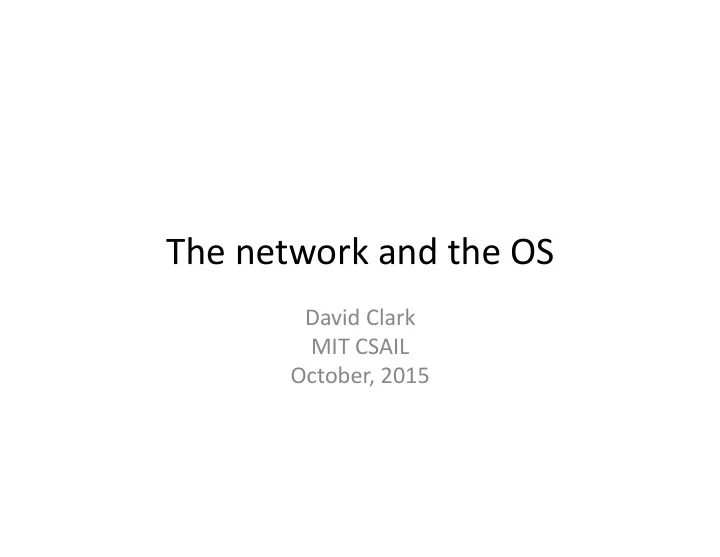

The ¡network ¡and ¡the ¡OS ¡ David ¡Clark ¡ MIT ¡CSAIL ¡ October, ¡2015 ¡
From ¡the ¡specific ¡to ¡the ¡cosmic ¡ • Early ¡issues ¡were ¡pragmaHc ¡and ¡“mechanical”. ¡ – How ¡to ¡structure ¡and ¡posiHon ¡the ¡code ¡that ¡ implemented ¡the ¡protocols. ¡ – Performance. ¡ • Later ¡issues ¡were ¡more ¡fundamental: ¡ – What ¡does ¡it ¡mean ¡for ¡a ¡machine ¡to ¡be ¡connected ¡to ¡ the ¡rest ¡of ¡the ¡world? ¡ – Security, ¡availability ¡
Structure ¡ • To ¡understand ¡the ¡issues ¡of ¡structure, ¡must ¡ understand ¡what ¡is ¡disHncHve ¡about ¡ implemenHng ¡network ¡protocols. ¡ ¡ – Start ¡there, ¡then ¡look ¡at ¡implicaHons ¡for ¡the ¡OS. ¡
What ¡is ¡different ¡about ¡net ¡I/O? ¡ • Variable ¡size ¡units ¡(packets ¡and ¡applicaHon ¡data). ¡ • Malformed ¡content ¡and ¡size. ¡ • Internet ¡connected ¡heterogeneous ¡machines ¡over ¡ heterogeneous ¡networks. ¡ ¡ • First ¡(and ¡in ¡some ¡sense ¡only) ¡goal ¡was ¡interoperaHon. ¡ • Byte ¡order, ¡9 ¡bit ¡bytes, ¡etc. ¡ ¡ • Unpredictable ¡arrival/transmission. ¡ • Must ¡be ¡processed ¡to ¡demulHplex. ¡ – Trustworthy ¡processing. ¡
A ¡1986 ¡perspecHve ¡ Our ¡state ¡of ¡understanding ¡in ¡1986: ¡ • A ¡slide ¡of ¡mine ¡from ¡the ¡Hme. ¡ There ¡was ¡deep ¡confusion ¡as ¡to ¡how ¡to ¡ move ¡from ¡protocol ¡specificaHon ¡to ¡ protocol ¡implementaHon. ¡
ImplemenHng ¡a ¡protocol ¡ • The ¡stages ¡in ¡our ¡understanding. ¡What ¡was ¡the ¡challenge? ¡ – ImplemenHng ¡the ¡state ¡machine. ¡ – Marshalling ¡the ¡packet ¡fields. ¡ ¡ – Dealing ¡with ¡errors. ¡ – Processing ¡32 ¡bit ¡numbers. ¡ – Copying ¡the ¡data. ¡ – Dealing ¡with ¡congesHon ¡control. ¡ – Dispatching ¡the ¡packet ¡to ¡correct ¡connecHon. ¡ – Dealing ¡with ¡layers ¡ ¡
Where ¡to ¡put ¡the ¡so_ware? ¡ Protocol ¡in ¡the ¡OS? ¡ • Low ¡overhead. ¡ • Nasty ¡programming ¡environment. ¡ • Run ¡all ¡the ¡code ¡at ¡interrupt ¡Hme? ¡ Protocol ¡in ¡the ¡applicaHon ¡process? ¡ • No ¡asynchrony. ¡ ¡ • Easy ¡invocaHon. ¡ Protocol ¡in ¡a ¡separate ¡process? ¡ • ¡High ¡cost ¡to ¡invoke. ¡ • Asynchronous ¡execuHon. ¡
WaiHng ¡for ¡events ¡ • Protocols ¡have ¡an ¡odd ¡(by ¡the ¡thinking ¡of ¡the ¡ day) ¡structure. ¡ – They ¡wait ¡for ¡mulHple ¡events. ¡ ¡ – A ¡user ¡event, ¡a ¡network ¡event, ¡a ¡Hmer ¡event. ¡ • Many ¡interprocess ¡scheduling ¡mechanisms ¡ required ¡the ¡waiHng ¡process ¡to ¡wait ¡on ¡one ¡ event. ¡ ¡
Performance ¡ • We ¡had ¡to ¡learn ¡the ¡relaHve ¡cost ¡of ¡different ¡ acHons. ¡ – Processing ¡a ¡header. ¡ – Scheduling ¡a ¡process/thread. ¡ – Secng ¡a ¡Hmer. ¡ – Taking ¡an ¡interrupt. ¡ – Copying ¡the ¡data. ¡ – Dispatching ¡the ¡packet. ¡
Protocols ¡can ¡be ¡ simple ¡ ImplementaHon ¡of ¡TCP ¡ input ¡rouHne ¡for ¡Xerox ¡ Alto. ¡ It ¡fit ¡on ¡one ¡page. ¡ – It ¡does ¡call ¡subrouHnes… ¡
Layers ¡of ¡protocol ¡ • Link, ¡IP, ¡TCP, ¡app. ¡ • How ¡should ¡the ¡code ¡be ¡structured? ¡ – Obvious ¡(but ¡bad) ¡idea: ¡structure ¡a ¡layer ¡as ¡a ¡process. ¡ – Why? ¡It ¡takes ¡(much) ¡longer ¡to ¡schedule ¡a ¡process ¡ than ¡process ¡a ¡packet. ¡ • Layering ¡is ¡a ¡device ¡for ¡specificaHon, ¡not ¡code ¡ structure. ¡
An ¡example-‑-‑TRIPOS ¡ • TRIPOS ¡(Cambridge ¡University) ¡was ¡wonderful ¡ligle ¡OS ¡ that ¡used ¡processes ¡for ¡most ¡system ¡funcHons. ¡(The ¡ micro-‑kernel ¡philosophy.) ¡ – Interprocess ¡communicaHon ¡by ¡pointer, ¡not ¡copy. ¡ • highly ¡efficient. ¡ – Network ¡code ¡structured ¡as ¡three ¡processes. ¡ • Network, ¡transport, ¡remote ¡login. ¡ – 54 ¡process ¡wakeups ¡to ¡exchange ¡a ¡character. ¡ ¡ – Recoding ¡as ¡one ¡process: ¡10x ¡smaller, ¡10x ¡faster ¡
The ¡consequence ¡of ¡processes ¡
Emerging ¡ideas ¡ • The ¡Structuring ¡of ¡Systems ¡Using ¡Upcalls” ¡ • David ¡Clark, ¡SOSP, ¡1985 ¡ • “Layered ¡MulHplexing ¡Considered ¡Harmful” ¡ • David ¡Tennenhouse, ¡First ¡InternaHonal ¡Workshop ¡on ¡ High ¡Speed ¡Networking, ¡1989 ¡
Some ¡pictures ¡of ¡upcalls ¡
Fixing ¡other ¡performance ¡problems ¡ • G. ¡Varghese ¡and ¡T. ¡Lauck. ¡ ¡Hashed ¡and ¡hierarchical ¡Hming ¡ wheels: ¡data ¡structures ¡for ¡the ¡efficient ¡implementaHon ¡of ¡a ¡ Hmer ¡facility. ¡In ¡ Proceedings ¡of ¡the ¡eleventh ¡ACM ¡Symposium ¡ on ¡Opera;ng ¡systems ¡principles ¡(SOSP ¡'87). ¡ACM, ¡New ¡York, ¡ NY, ¡USA, ¡ ¡
Packet ¡processing ¡ • Clark, ¡D.D.; ¡Romkey, ¡J.; ¡Salwen, ¡H., ¡"An ¡analysis ¡of ¡TCP ¡processing ¡ overhead," ¡in ¡ Local ¡Computer ¡Networks, ¡1988., ¡Proceedings ¡of ¡the ¡ 13th ¡Conference ¡on ¡, ¡vol., ¡no., ¡pp.284-‑291, ¡10-‑12 ¡Oct ¡1988 ¡ • TCP ¡packet ¡receipt: ¡ ¡ – Sender ¡of ¡data: ¡191-‑235 ¡instrucHons ¡ – Receiver ¡of ¡data, ¡186 ¡instrucHons. ¡ – Set ¡a ¡Hmer: ¡35 ¡(used ¡Hming ¡wheel ¡algorithm) ¡ – Internet ¡protocol: ¡~60 ¡
A ¡range ¡of ¡topics ¡ Early ¡issues ¡were ¡performance ¡ • • Network ¡so_ware ¡design ¡ Homogeneity ¡ • Co-‑processing ¡ • Small ¡machines ¡ ¡ • From ¡Alto, ¡PC, ¡(to ¡IoT). ¡ – Parallel ¡machines ¡ • AlternaHve ¡network ¡semanHcs ¡ • High-‑level ¡implicaHons ¡of ¡ ¡connecHvity ¡to ¡the ¡world ¡ • Security, ¡availability, ¡etc. ¡ – Virtual ¡networks ¡and ¡virtual ¡computers ¡ • Speed ¡of ¡light ¡ •
The ¡recurring ¡structural ¡issue ¡ Networks ¡have ¡a ¡disHnct ¡set ¡of ¡issues ¡to ¡solve. ¡ • – Resource ¡allocaHon, ¡security, ¡managing ¡delivery. ¡ But ¡they ¡do ¡not ¡know ¡what ¡they ¡are ¡being ¡used ¡for. ¡(The ¡end ¡to ¡end ¡ • model). ¡ ¡ – What ¡is ¡core ¡and ¡what ¡is ¡overlay? ¡ • TCP ¡persists ¡because ¡we ¡found ¡no ¡other ¡general ¡service ¡model. ¡ – The ¡alternaHve ¡is ¡to ¡push ¡to ¡the ¡app ¡the ¡implementaHon ¡of ¡the ¡desire ¡semanHcs. ¡(UDP.) ¡ ¡ – But ¡then ¡app ¡designer ¡is ¡implemenHng ¡the ¡protocol. ¡See ¡earlier ¡part ¡of ¡talk. ¡ ¡ – Is ¡the ¡protocol ¡(e.g., ¡transport) ¡a ¡core ¡service? ¡ The ¡net ¡cannot ¡trust ¡the ¡host, ¡the ¡OS ¡cannot ¡trust ¡the ¡app, ¡the ¡app ¡cannot ¡ • trust ¡any ¡of ¡them, ¡and ¡the ¡resulHng ¡system ¡should ¡have ¡some ¡sort ¡of ¡ reliability. ¡
Recommend
More recommend